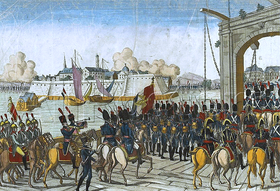Capitulation of Stettin
| Capitulation of Stettin | |||||||
|---|---|---|---|---|---|---|---|
| Part of the War of the Fourth Coalition | |||||||
 Taking of Stettin by French troops in 1806 |
|||||||
|
|||||||
| Belligerents | |||||||
|
|
|
||||||
| Commanders and leaders | |||||||
|
|
|
||||||
| Strength | |||||||
| 800, 2 guns | 5,300, 281 guns | ||||||
| Casualties and losses | |||||||
| None | 5,300 captured, 281 guns captured |
||||||
In the Capitulation of Stettin on 29–30 October 1806, Lieutenant General Friedrich Gisbert Wilhelm von Romberg surrendered the garrison and fortress to a much smaller French light cavalry brigade led by General of Brigade Antoine Lasalle. This event was one of a number of surrenders by demoralized Prussian soldiers to equal or inferior French forces after their disastrous defeat at the Battle of Jena-Auerstedt on 14 October. Stettin, now Szczecin, Poland, is a port city on the Oder River near the Baltic Sea lying 120 kilometers north-northeast of Berlin.
After Jena-Auerstedt, the broken Prussian armies crossed the Elbe River and fled to the northeast in an attempt to reach the east bank of the Oder. Following a two-week chase, Marshal Joachim Murat intercepted over 10,000 Prussians at the Battle of Prenzlau and bluffed them into surrendering on 28 October. The following day, Lasalle's and another French light cavalry brigade induced 4,200 more Prussians to lay down their weapons in the Capitulation of Pasewalk. On the afternoon of the 29th, Lasalle appeared before the fortress of Stettin and demanded its surrender. A completely unnerved Romberg, believing he was confronted by 30,000 Frenchmen, entered into negotiations with Lasalle and surrendered Stettin that night. Estimates of the numbers vary between 500 French hussars of the 5th and 7th French Hussars and 5,000 to 6,000 Prussians within the garrison.
Within a week, the fortress of Küstrin capitulated and three isolated Prussian columns were hunted down and captured at Boldekow, Anklam, and Wolgast. This left only one Prussian corps at large between the Elbe and Oder, plus garrisons at Magdeburg and in the former Electorate of Hanover.
...
Wikipedia
